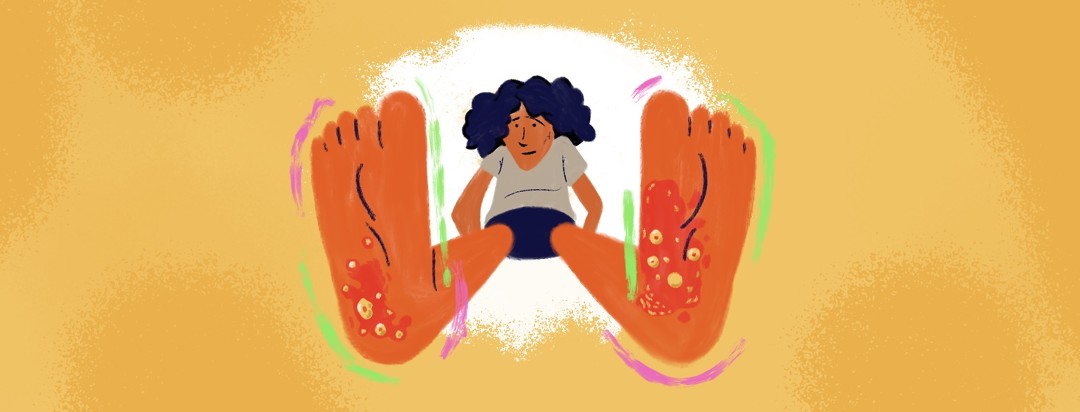Are There Different Types of Pustular Psoriasis?
Psoriasis is a relatively common skin condition that affects people all over the world. Research shows that psoriasis affects about 3 percent of the adult population, totaling more than 7.5 million adults.1
There are several different types of psoriasis. Some people may live with just one type, others may have more than one type at once. The most common type of psoriasis is called plaque psoriasis, which affects up to 80 percent of people with psoriasis.2
Plaque psoriasis causes raised patches of inflamed, itchy, and painful skin along with scales (plaques) that may look silvery-white or purple.2
While plaque psoriasis is fairly common and can appear anywhere on the body, pustular psoriasis is a different, rare form of psoriasis. Roughly 3 percent of people with psoriasis develop pustular psoriasis at least once during their lifetime. It is more common in adults than children.2,3
What does pustular psoriasis look like?
Pustular psoriasis appears as small white or yellow fluid-filled blisters that may be surrounded by red, discolored, or scaly skin. The skin may also feel painful or itchy.1,3
In some cases, the pustules may join together and burst open. The fluid inside the pustules is not contagious.1,3
What triggers pustular psoriasis?
Environmental allergens or irritants may trigger pustular psoriasis in some people. Other factors that may trigger pustular psoriasis include:2,3
- A reaction to a medicine
- Starting or stopping certain medicines
- Stress
- Overexposure to ultraviolet (UV) light
- Infections
- Pregnancy
What are the main subtypes of pustular psoriasis?
There are 3 main subtypes of pustular psoriasis. They all look slightly different, and they show up on different parts of the body. Like plaque psoriasis, pustular psoriasis generally ebbs and flows, becoming more or less serious at different times. Periods when the disease is more severe are known as flares.2,3
Palmoplantar pustulosis (PPP)
Palmoplantar pustulosis (PPP) causes pustules on the palms of the hands, the soles of the feet, or both. PPP is sometimes called palmoplantar pustular psoriasis or localized pustular psoriasis. PPP may occur with or without plaque psoriasis.2-4
PPP is much more common in women than in men, and most people with PPP are current or past smokers. PPP symptoms may range from mild to severe and last for years. Because the pustules occur on the hands and feet, PPP can impact day-to-day functioning.2-4
PPP can be hard to treat, so doctors may use a combination of medicines. Treatment often begins with strong topical steroid creams. Oral retinoids and light therapy may also be used.5
Acrodermatitis continua of Hallopeau (ACH)
Acrodermatitis continua of Hallopeau (ACH) is a rare subtype of pustular psoriasis. ACH only affects the tips of the fingers or toes and the nails. In most cases, ACH starts on one finger or toe but can spread. ACH is usually triggered by damage or trauma to the area. ACH is most common in women.6
ACH is painful and can cause damage to the nail bed. In some cases, people with ACH may have deformed nails or even lose their affected nails. Severe cases of ACH may damage the bone at the tip of the affected finger or toe.6
Since ACH is rare, there are no standard treatment guidelines. ACH is also hard to treat. Some research shows that topical medicines and light therapy may be helpful, and there is growing evidence for treatment with biologic medicines.6,7
Generalized pustular psoriasis (GPP)
Generalized pustular psoriasis (GPP) impacts large areas of the body. It is also known as von Zumbusch psoriasis.8
While very rare, GPP can develop suddenly and be dangerous or even life-threatening. As the pustules and plaques spread, they may also cause severe symptoms like:8
- Fever
- Chills
- Severe itching
- Change in heart rate
- Tiredness
- Muscle weakness
If you have sudden symptoms of GPP, get medical help right away.8
GPP is slightly more common in women than in men. It can also impact children. GPP may be triggered by infections, stress, steroid withdrawal, and pregnancy.8
Since GPP can become life-threatening, it needs to be treated quickly. People experiencing GPP flares are usually hospitalized and given fluids and medicines to prevent dehydration, regulate body temperature, and prevent infections. Once a person with GPP is stable, treatment may include oral retinoids and biologics, as well as antibiotics for infection.8

Join the conversation